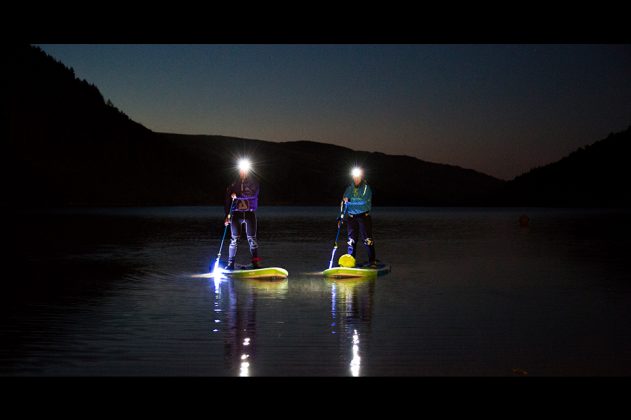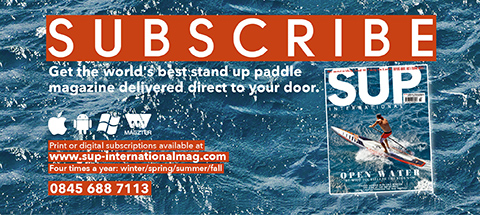GET PSYCHED #3 –
NIGHT PADDLE BOARDING
With – Sian Sykes
I love the silence, the stillness and calm at dusk. The night shift begins, bats fly and owls begin to hoot. Watching the last splashes of colour fade. Stars, one by one, begin to fill up the sky and the bright white moon rises to guide you on the water as its shiny white reflections ripple across the water. The senses are heightened, daytime distractions disappear and you ‘hear the invisible starfall’ (quote: Dylan Thomas). Tempted? Here are my suggestions for planning an enjoyable and successful night paddleboarding trip.
Moonlight
Try planning your first night paddle on a clear night with a new or, better still, a full moon.
Weather
Key for all paddlers is in the planning. Before jumping on the water, check the local wind direction, air temperature, tides, and forecast prior to your night paddling trip. If you use a smartphone, find apps that are useful in checking local weather conditions.
Ability
When thinking of preparing for your night paddle, you need firstly to base it around your level of ability, to allow you to be fully prepared. Certainly enthusiasm does help, but your ability will guide you through to minimise any potential ‘epics’. When embarking on your night paddle, not only do you need to consider yourself, but any impact you might have on others, for example your fellow paddlers, rescue services and the general public. Stay within your skill level. If in doubt, don’t go out.
Minimise faff time
When embarking on paddleboarding especially at night, minimise the faff as it eats into time and you can easily start to get cold. Know where things are and have a system. Things can be left behind especially when preparing to set off or after stops. Get into a habit that has you keeping kit in certain places to minimise the panic and frustration trying to find it in the dark.
Dress appropriately
Dress for chillier night time temperatures, and be aware that paddling at night requires more navigation than day time so hence more stopping and starting. Dress for the water temperature even if you don’t plan on getting wet. Bring extra warm layers. I get larger jackets which can easily be thrown over my paddling kit to keep me warm and toasty. Store a drybag on your SUP to place all your warm layers into, including warm hat and gloves.
“The senses are heightened, daytime distractions disappear and you ‘hear the invisible starfall’ to quote Dylan Thomas. Are you tempted?”
Hot drink and snacks
While on the water, take a warm drink in a thermos to keep you warm and hydrated. Hot chocolate is always a winner and some dunking biscuits or snacks too!
Lighting – to be seen
Ensure you and your board have lights so you can easily be seen. I have a light at the nose and at the tail of my board. I wear a headtorch and carry spare batteries. My personal preference is that I use this sparingly. For the paddle, it is best to strap reflective tape around should you drop it in the water so you can easily spot it. Some paddling kit (such as Peak UK) has reflective tape on the sleeves so you can easily be spotted on the water.
Navigation
Don’t rely upon on shore lights as landmarks as they may be turned off! When I first started out paddling, I left a light on my car dashboard which I used as a marker. Carry a waterproof map and compass. I print off smaller maps and laminate so I don’t carry a big bulky map on me. I still have the larger map stashed in a dry bag just in case. Have a ‘soft’ light source for map / chart reading rather than using your headtorch and destroying your night vision. Have a small backup headtorch or flash light in a drybag in your emergency kit dry bag. Judging distance at night is at times tricky. Moonlight can make objects appear further away. So, while navigating at night, trust your compass and watch and not your impaired night vision!
Incident Management
Should an incident occur what are your escape routes? Escape routes need prior planning.
Communication
How are you going to communicate for example to the emergency services? Does the area you are paddling have mobile phone signal? Are there houses nearby?
Here is my recommended kit list:
• Warm jacket – Think of layers to keep you snug and warm
• Lightweight rain jacket
• Hat and gloves
• Head torch & spare batteries
• Lights for nose and tail of SUP
• Reflective tape around paddle
• Emergency dry bag kit, flare, GPS, SPOT device, first aid kit, repair kit, warm layers, map
• Whistle
• Communication device
• Laminated print off map and compass. Please make sure you know how to use! Tide info, if appropriate, and weather forecast
• Penknife
• Hot drink and snacks
SUP
ABOUT SIAN
Sian is a fully qualified International Mountain Leader and SUP instructor in Wales, UK and runs her own business Psyched Paddleboarding. Sian has travelled the world, building up vast experience of leading expeditions to Nepal, Mongolia, India, China, Peru, Morocco, Iceland, Europe and the Alps. Sian’s mission is to inspire others to SUP and to offer high quality SUP training and safety advice. She offers memorable stand up paddle boarding adventures whether hiking to a tranquil wilderness lake, exploring stunning coastlines and of course leading SUP expeditions.


